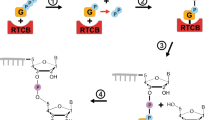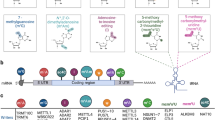Abstract
The poly(A)-binding protein PAB1 from the yeast Saccharomyces cerevisiae plays an important role in controlling mRNA deadenylation rates. Deletion of either its RRM1 or proline-rich domain (P domain) severely restricts deadenylation and slows mRNA degradation. Because these large deletions could be having unknown effects on the structure of PAB1, different strategies were used to determine the importance of the RRM1 and P domains to deadenylation. Since the P domain is quite variable in size and sequence among eukaryotes, P domains from two human PABPCs and from Xenopus were substituted for that of PAB1. The resultant PAB1 hybrid proteins, however, displayed limited or no difference in mRNA deadenylation as compared with PAB1. In contrast to the P domain, the RRM1 domain is highly conserved across species, and a systematic mutagenesis of the RRM1 domain was undertaken to identify its functional regions. Several mutations along the RNA-binding surface of RRM1 inhibited deadenylation, whereas one set of mutations on its exterior non-RNA binding surface shifted deadenylation from a slow distributive process to a rapid processive deadenylation. These results suggest that the RRM1 domain is the more critical region of PAB1 for controlling deadenylation and consists of at least two distinguishable functional regions.






Similar content being viewed by others
References
Cao D, Parker R (2001) Computational modeling of eukaryotic mRNA turnover. RNA 7:1192–1212
Chen J, Chiang Y-C, Denis CL (2002) CCR4, a 3′-5′ poly (A) RNA and ssDNA exonuclease, is the catalytic component of the cytoplasmic deadenylase. EMBO J 21:1414–1426
Coller J, Parker R (2004) Eukaryotic mRNA decapping. Annu Rev Biochem 73:861–890
Cui Y, Denis CL (2003) In vivo evidence that defects in transcription elongational factors, RPB2, TFIIS, and SPT5 enhance upstream poly (A) site utilization. Mol Cell Biol 23:7887–7901
Deardorff JA, Sachs AB (1997) Differential effects of aromatic and charged residue substitutions in the RNA binding domains of the yeast poly(A)-binding protein. J Mol Biol 269:67–81
Decker CJ, Parker R (1993) A turnover pathway for both stable and unstable mRNAs in yeast: evidence for a requirement for deadenylation. Genes Dev 7:1632–1643
Deo RC, Bonanno JB, Sonenberg N, Burley SK (1999) Recognition of polyadenylate RNA by the poly(A)-binding protein. Cell 98:835–845
Draper MP, Salvadore C, Denis CL (1995) Identification of a mouse protein whose homolog in yeast is a component of the CCR4 transcriptional regulatory complex. Mol Cell Biol 15:3487–3495
Hoshino S, Imai M, Kobayashi T, Uchida N, Katada T (1999) The eukaryotic polypeptide chain releasing factor (eRF3/GSPT) carrying the translation termination signal to the 3′-poly(A) tail of mRNA. Direct association of erf3/GSPT with polyadenylate-binding protein. J Biol Chem 274:16677–16680
Hosoda N, Kobayashi T, Uchida N, Funakoshi Y, Kikuchi Y, Hoshino S, Katada T (2003) Translation termination factor eRF3 mediates mRNA decay through the regulation of deadenylation. J Biol Chem 278:38287–38291
Lee D, Ohn T, Chiang Y-C, Liu Y, Quigley G, Yao G, Denis CL (2010) PUF3 acceleration of deadenylation in vivo can operate independently of CCR4 activity, possibly involving effects on the PAB1-mRNP structure. J Mol Biol 399:562–575
Lindstein T, June CH, Ledbetter JA, Stella G, Thompson CB (1989) Regulation of lymphokine messenger RNA stability by a surface-mediated T cell activation pathway. Science 244:339–343
Liu H-Y, Badarinarayana V, Audino DC, Rappsilber J, Mann M, Denis CL (1998) The NOT proteins are part of the CCR4 transcriptional complex and affect gene expression both positively and negatively. EMBO J 17:1096–1106
Muhlrad D, Decker CJ, Parker R (1994) Deadenylation of the unstable mRNA encoded by the yeast MFA2 gene leads to decapping followed by 5′-3′ digestion of the transcript. Genes Dev 8:855–866
Ohn T, Chiang Y-C, Lee DJ, Yao G, Zhang C, Denis CL (2007) CAF1 plays an important role in mRNA deadenylation separate from its contact to CCR4. Nucl Acids Res 35:3002–3015
Olivas W, Parker R (2000) The Puf3 protein is a transcript-specific regulator of mRNA degradation in yeast. EMBO J 19:6602–6661
Otero LJ, Ashe MP, Sachs AB (1999) The yeast poly(A)-binding protein Pab1p stimulates in vitro poly(A)-dependent and cap-dependent translation by distinct mechanisms. EMBO J 18:3153–3163
Richardson R, Denis CL, Zhang C, Nielsen MO, Chiang YC, Kierkegaard M, Wang X, Lee DJ, Andersen JS, Yao G (2012) Mass spectrometric identification of proteins that interact with specific domains of the poly(A) binding protein. Mol Genet Genomics 271:711–730
Schwartz DC, Parker R (1999) Mutations in translation initiation factors lead to increased rates of deadenylation and decapping of mRNAs in Saccharomyces cerevisiae. Mol Cell Biol 19:5247–5256
Simon E, Seraphin B (2007) A specific role for the C-terminal region of the poly(A)-binding protein in mRNA decay. Nucl Acids Res 35:6017–6028
Tucker M, Valencia-Sanchez MA, Staples RR, Chen J, Denis CL, Parker R (2001) The transcription factor associated proteins, Ccr4p and Caf1p, are components of the major cytoplasmic mRNA deadenylase in Saccharomyces cerevisiae. Cell 104:377–386
Tucker M, Staples RR, Valencia-Sanchez MA, Muhlrad D, Parker R (2002) CCR4p is the catalytic sub-unit of Ccr4p/Pop2p/Notp mRNA deadenylase ecomplex in Saccharomyces cerevisiae. EMBO J 21:1427–1436
Viswanathan P, Chen J, Chiang Y-C, Denis CL (2003) Identification of multiple RNA features that influence CCR4 deadenylation activity. J Biol Chem 278:14949–14955
Viswanathan P, Ohn T, Chiang Y-C, Chen J, Denis CL (2004) Mouse CAF1 can function as a processive deadenylase 3′-5′-exonuclease in vitro but in yeast the deadenylase function of CAF1 is not required for mRNA poly(A) removal. J Biol Chem 279:23988–23995
Voeltz GK, Ongkasuwan J, Standart N, Steitz JA (2001) A novel embryonic poly(A) binding protein, ePAB, regulates mRNA deadenylation in Xenopus egg extracts. Genes Dev 15:774–778
Wang X, Zhang C, Chiang Y-C, Toomey S, Power MP, Granoff ME, Richardson R, Lee DJ, Xi W, Laue TM, Denis CL (2012) Use of the novel technique of analytical ultracentrifugation with fluorescent detection system identifies a 77S monosomal translation complex. Protein Sci 21:1253–1268
Yang H, Duckett CS, Lindstein T (1995) iPABP, an inducible poly(A)-binding protein detected in activated human T cells. Mol Cell Biol 15:6770–6776
Yao G, Chiang Y-C, Zhang C, Lee D, Denis CL (2007) PAB1 self-association precludes its binding to poly (A), thereby accelerating CCR4 deadenylation in vivo. Mol Cell Biol 27:6243–6253
Acknowledgments
This research was supported by NIH grants GM78087 and GM82048 and from the ARRA initiative of 2009. Partial funding was provided by the New Hampshire Agricultural Experiment Station to C.L.D. This is Scientific Contribution Number 2514.
Author information
Authors and Affiliations
Corresponding author
Additional information
Communicated by A. Aguilera.
Rights and permissions
About this article
Cite this article
Zhang, C., Lee, D.J., Chiang, YC. et al. The RRM1 domain of the poly(A)-binding protein from Saccharomyces cerevisiae is critical to control of mRNA deadenylation. Mol Genet Genomics 288, 401–412 (2013). https://doi.org/10.1007/s00438-013-0759-3
Received:
Accepted:
Published:
Issue Date:
DOI: https://doi.org/10.1007/s00438-013-0759-3




